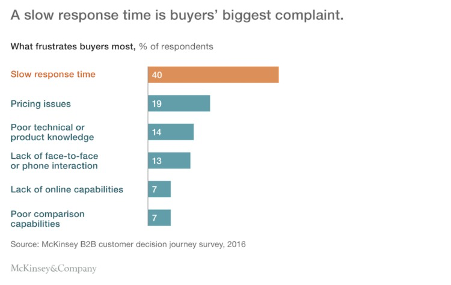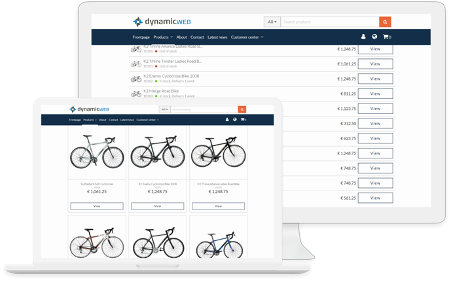B2B Demand Generation: Future of B2B Ecommerce
B2B ecommerce has been growing over the past few years and isn’t planning to slow down. Ranging from manufacturers that decide to go directly to consumer, to organizations that are moving from carbon sheets to offering a great personalized/individual B2B ecommerce experience.

Research shows that B2B ecommerce is expected to grow by 17.5% CAGR in the next 6 years. I believe this to be conservative, certainly if you take Mckinsey’s research into account that digital savvy B2B organizations can have 5 times higher revenue numbers than their competitors that still work within the stone age.
There are many reasons why B2B buyers expect more these days. They have grown accustomed to getting what they need instantly and when it fits them as consumers and to some degree expect the same in business.
B2B Ecommerce Challenges
B2B buying cycles can be lengthier compared to their B2C counterparts, slow response times are in the absolute top of frustrations that B2B buyers encounter. Let alone waiting for that call with the sales manager only to find out that their knowledge doesn’t go as deep as expected. Time wasted; customer experience shattered.

This report by dynamicweb - The New Potential in B2B Ecommerce focuses on some of the most complex challenges within B2B ecommerce and shows how successful businesses have managed to turn them into competetive advantages.
Customer Experience – Across all Channels
89% of B2B buyers say the overall experience is as important as the products and services the organization offers, according to the Salesforce State of the Connected Customer study.
And although the trend continues to lean in favor of online, there is still a significant offline part in the more complex B2B relations. In Forrester’s Winning the new B2B Buyer study it shows that between 2015 and 2019 the self-service part of customers has grown from 14% to 18%, while purchasing through sales reps declined from 46% to 42% over the same period.
Today, the B2B buyer expects to continue the offline conversation based on explicit and implicit online behavior on the website. The ability to drive the right product information to the customer depending on their on-and-offline behavior across all channels is what makes a fantastic omnichannel customer experience.
As the numbers show, certainly in the more complex customer relations with account specific (customized) products and spare-parts, we still rely on account managers and sales reps. And here is where sales reps equipped with the right technology can make a difference. Imagine the customer approach where the sales rep offers the customer a pre-loaded cart with all the right recommended products and custom customer specific prices and discounts that they can go through either together or at the convenience of the customer. A solution that is perceived as a key contributor to great experiences and customer centric approach.
Personalized Account Specific Storefronts
As we are arriving at offering the best possible experience, having a personalized front facing strategy for your ecommerce website can have a tremendous positive effect on the experience. The ability to offer dynamic pricelists, custom catalogs and even account specific storefronts are major influencers on great experiences and winning the customer.
Gartner predicted that more than 70% of B2B companies would offer some form of personalization on their website by 2018. Today, 77% of companies believe personalization should be a bigger priority for their organization than it previously had been.

There is still a great opportunity to get ahead of your competitors to act swiftly and get a modern ecommerce website and ecommerce platform that is able to integrate into your enterprise resource planning (ERP) and customer relationship management (CRM) systems empowering you to apply digital marketing initiatives like described earlier.
Integration to ERPs, PIMs and CRMs
Topics mentioned through-out this blogpost have a need to be fed. Enter ERP and CRM integration. Customer specific product information needs to be integrated from a combination of systems. Ranging from the enterprise resournce planning (ERP) system, like Microsoft Dynamics CRM, SAP or AFAS, to the product information management (PIM) solution. The combination of these systems enables customer specific rules towards custom catalogs and custom pricing, and all other types of customer related deals.
And here it might become a bit more technical, but technology excellence is something to be aware of. By integrating your front-end ecommerce solution with ERPs a sharp eye needs to be applied to the integration. If the front-end or the ERP side has too many API calls, or API calls to slow down the front-end, it can have a direct negative effect on the experience or even have the whole thing go down.
The omnichannel experience referenced a couple of times as well will be a combination of solutions working together. Ranging from marketing automation that is either part of the platform, to integrations via frameworks and APIs, to customer-facing B2B ecommerce personalization based on off-and-online touchpoints synchronized from CRM to the content management system (CMS) and ecommerce user database and vice versa.
Conclusion
B2B ecommerce continues to be up and coming, approximately 20% of B2B purchases are fully self-service based according to the latest Forrester Winning the New B2B Buyer. Many reports show that becoming digitally mature allows you to get impressive business performance results while offering a better customer experience.
Although there are many options on the market and projects can become complex quickly, it is a matter of getting started. There are turnkey solutions available by various vendors, but little that have ecommerce, CMS, digital marketing, product information management and ERP integration as a standard offering available. This can get you up and running in a matter of days, where it will have over 80% of the functionality to get you started, where the remaining 20% allows it to be customized towards the individual needs and a roadmap to be ahead of the market.